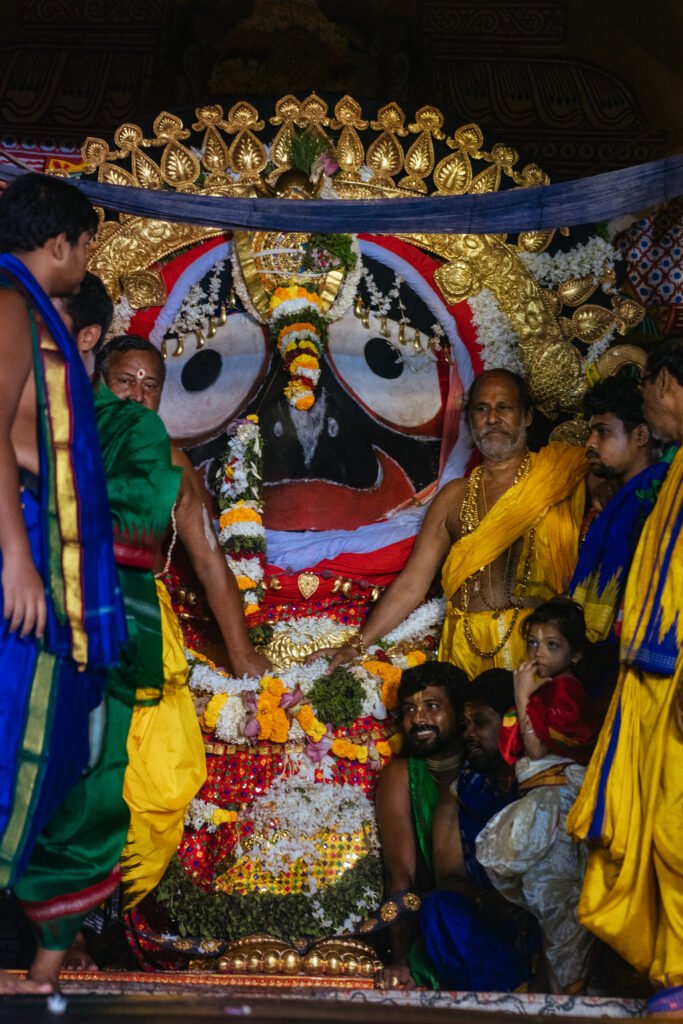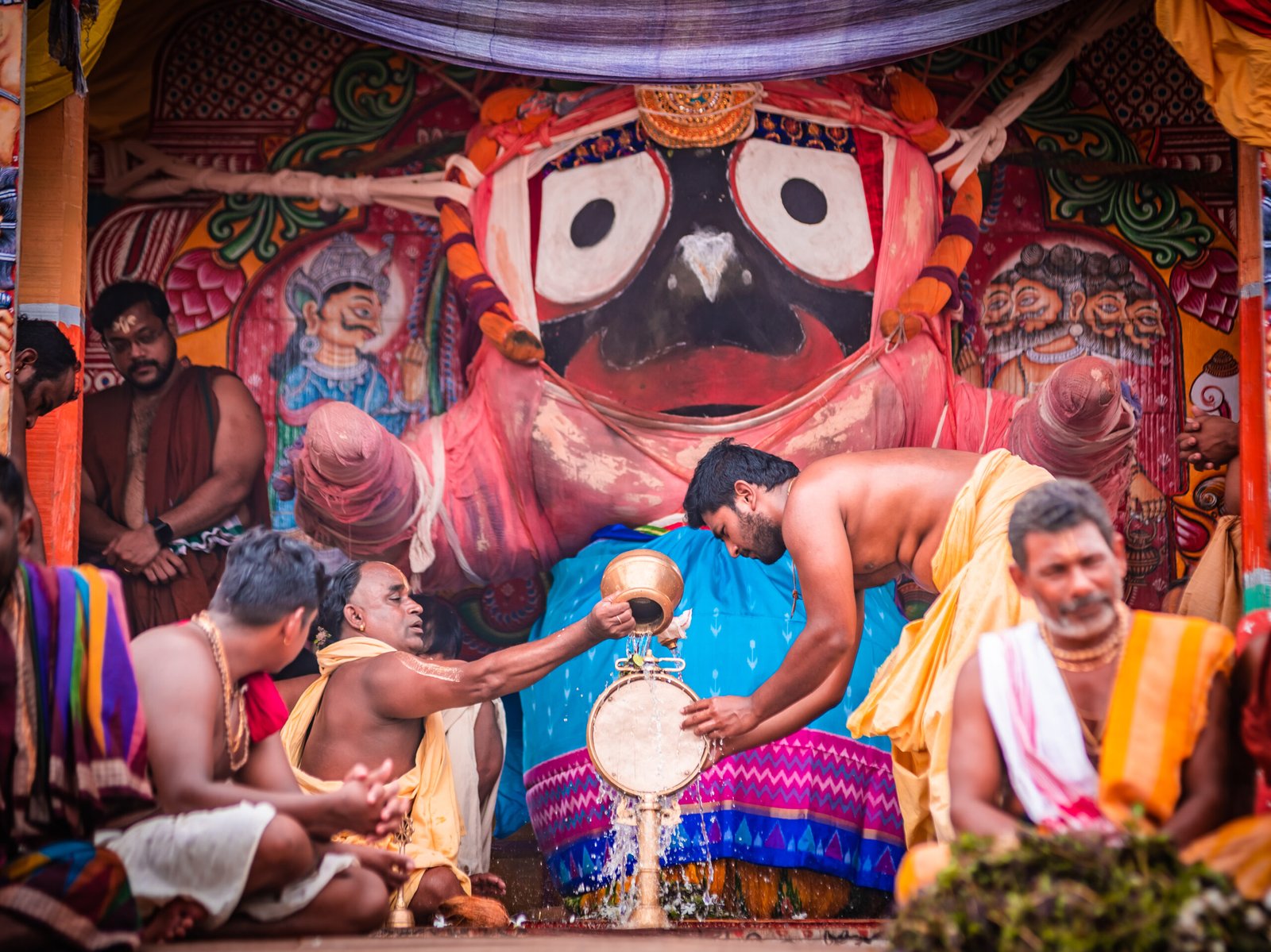32 Beshas of Lord Jagannath ଜଗନ୍ନାଥଙ୍କ ବେଶର ନାମ (Besha ବେଶ, meaning “attire” or “costume”) are an important part of the ritualistic and cultural tradition of the Jagannath Temple, Puri. Each Besha carries deep spiritual meaning, linked to Hindu mythology, Vaishnava philosophy, local traditions, and temple history. These Beshas are adorned either daily, occasionally, or on special festival days, symbolizing different forms and leelas of the Lord.
1. Abakasha Besha (Daily Morning Attire)
- When: Every morning after Mangala Arati.
- Description: Lord Jagannath, Balabhadra, and Subhadra are adorned after their ritualistic bath and brushing of teeth. They are dressed simply in fresh cloth.
- Significance: Symbolizes cleanliness, daily ablutions, and preparation for the day. Reflects the human-like activities of the Lord.
2. Mailama Besha
- When: After the Abakasha rituals.
- Description: The deities are dressed with cloth and ornaments received from devotees.
- Significance: Represents humility — the Lord accepts whatever His devotees offer.
3. Sradha Besha
- When: During Shraddha rituals.
- Description: The deities wear a sober attire resembling that worn during ancestral homage.
- Significance: Shows that the Lord also respects ancestors and upholds dharma.
4. Chandan Besha
- When: On Akshaya Tritiya (April–May).
- Description: Deities are smeared with sandalwood paste and decorated with flowers.
- Significance: Marks the beginning of Chandan Yatra, symbolizes coolness during summer, and the soothing nature of divinity.
5. Ganesh Besha
- When: On Ganesh Chaturthi (August–September).
- Description: Lord Jagannath is dressed in the form of Lord Ganesh with elephant-like ornaments.
- Significance: Symbolizes that all deities reside in Jagannath, and He manifests as all gods.
6. Haladi (Turmeric) Besha
- When: Occasional ritual days.
- Description: The Lords are smeared with turmeric and dressed in yellow cloth.
- Significance: Turmeric symbolizes purity, auspiciousness, and healing.
7. Lakshmi Besha
- When: During Lakshmi Puja or Thursdays dedicated to Goddess Lakshmi.
- Description: Jagannath is dressed as Goddess Lakshmi with ornaments.
- Significance: Reflects the Lord’s oneness with Shakti.
8. Naba Jaubana Besha
- When: After Snana Purnima (bathing festival, June).
- Description: After the deities recover from “Anasara” (fortnight-long rest due to fever after bathing), they appear with a youthful look.
- Significance: Symbolizes rejuvenation, youth, and new life.
9. Suna Besha (Golden Attire)
- When: Five times a year — notably after Rath Yatra on the chariot, Kartik Ekadashi, Dussehra, etc.
- Description: Lord Jagannath, Balabhadra, and Subhadra are adorned with gold ornaments, weapons, and crowns.
- Significance: Symbolizes the Lord as the universal king (Rajadhiraja).
10. Krishna Balaram Besha
- When: On Kartika Purnima.
- Description: Jagannath is dressed as Krishna and Balabhadra as Balaram.
- Significance: Celebrates the bond of the divine brothers.
11. Radha Damodara Besha
- When: During the month of Kartika (October–November).
- Description: Jagannath is dressed as Krishna with Radha.
- Significance: Devotion of Radha-Krishna emphasized in Vaishnavism.
12. Gaja Uddharana Besha
- When: Magha Shukla Panchami.
- Description: Jagannath is dressed as Vishnu saving elephant king Gajendra from the crocodile.
- Significance: Shows the Lord as protector of devotees in distress.
13. Padma Besha
- When: Any Friday in Kartika month.
- Description: Deities are decorated with lotus flowers.
- Significance: Lotus symbolizes purity and divine creation.
14. Gajanana Besha/Gaja Besha/Hathi Besha
- When: Special rituals in Kartika.
- Description: Deities dressed with elephant-themed ornaments.
- Significance: Symbolizes royal and divine strength.
15. Bagha Besha (Tiger Attire)
- When: On Dashahara (Bijaya Dashami).
- Description: Jagannath and Balabhadra dressed in tiger-skin-like attire.
- Significance: Symbolizes fierce protector form of the Lord.
16. Banabhoji Besha
- When: Kartika month.
- Description: Jagannath is dressed as Krishna enjoying picnic in Vrindavan forest.
- Significance: Relates to Gopala Krishna’s leela with cowherd friends.
17. Kaliya Dalana Besha
- When: Bhadraba Krushna Ekadashi.
- Description: Jagannath is dressed as Krishna defeating serpent Kaliya.
- Significance: Symbolizes triumph over evil.
18. Pralambasura Badha Besha
- When: In Shravan month.
- Description: Jagannath dressed as Krishna killing demon Pralamba.
- Significance: Illustrates Lord’s role as destroyer of adharma.
19. Krishna Balaram Besha (Alternative)
- When: On Rukmini Harana Ekadashi.
- Significance: Reenactment of Krishna and Balarama leelas.
20. Bankachuda Besha
- When: Falguna month, Amavasya.
- Description: Jagannath appears as Krishna defeating demon Bankachuda.
- Significance: Protects devotees from ego and arrogance.
21. Bhanda Besha
- When: Chaitra month.
- Description: Jagannath is dressed with warrior-like attire.
- Significance: Reflects preparation for cosmic war against evil.
22. Govardhana Dhari Besha
- When: Kartik Shukla Pratipada.
- Description: Jagannath is dressed as Krishna lifting Govardhan mountain.
- Significance: Protection of devotees against Indra’s wrath (ego).
23. Nagarjuna Besha
- When: Rare — observed when Panchuka (last 5 days of Kartika) has 6 days. Last held in 2020.
- Description: Jagannath is dressed as warrior Arjuna/Nagarjuna with weapons.
- Significance: Symbolizes Lord as divine warrior and protector.
24. Rajadhiraja Besha
- When: During Rath Yatra return (Bahuda Yatra).
- Description: Lords dressed as emperors.
- Significance: Showcases Jagannath as King of the Universe.
25. Raghunatha Besha
- When: During Kartika month.
- Description: Jagannath is dressed as Lord Rama.
- Significance: Shows unity of Vishnu’s avatars.
26. Harihara Besha
- When: On Ekadashi in Kartika.
- Description: Combination of Vishnu (Hari) and Shiva (Hara).
- Significance: Unity of Shaivism and Vaishnavism.
27. Tribikrama Besha/Bali Vamana Besha
- When: Shravan Purnima.
- Description: Lord as Vamana taking giant form Trivikrama to subdue Bali.
- Significance: Represents dharma’s victory.
28. Jamadagni Besha (Parashurama)
- When: On Akshaya Tritiya or special occasions.
- Description: Jagannath dressed as Parashurama.
- Significance: Symbolizes warrior ascetic avatar of Vishnu.
29. Chacheri Besha
- When: On Holi (Falguna Purnima).
- Description: Lords dressed with flowers, sandalwood, and colors.
- Significance: Celebration of Holi with Krishna’s rasa leela.
30. Krishna Leela Besha
- When: Janmashtami.
- Description: Jagannath is dressed as baby Krishna with ornaments.
- Significance: Marks Krishna’s birth celebration.
31. Radha Krishna Besha
- When: During Kartika month.
- Description: Jagannath takes Krishna’s form, while Subhadra appears as Radha.
- Significance: Symbol of supreme bhakti and divine love.
32. Shakra Besha
- When: During rituals connected to Indra (rare).
- Description: Lord Jagannath is dressed as Indra, the king of gods.
- Significance: Shows Jagannath as supreme over all devas.








Leave a Reply